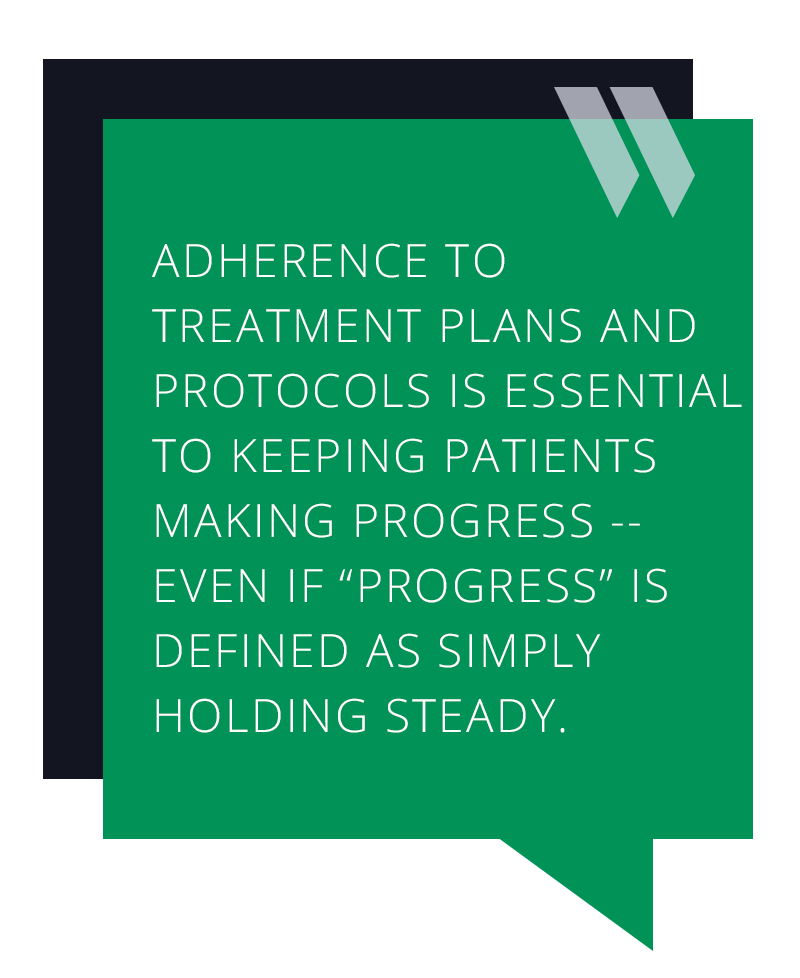Rowers get arthritis in their hands.
I knew it was a possibility when I was in college — our team doctors made it clear that this would be a downstream effect later in life. It was worth it, obviously, for an experience that fundamentally shaped me as a person. That said, I didn’t much relish the prospect. But recently I was at the doctor’s discussing it and got good news. “Congratulations,” the doctor said. “It’s not very far along at all.”
Whew.
The trick now is to keep it at this stage for as long as possible — but the reality is, it’s always going to be there and will eventually get worse. But whether it’s relatively mild (if bothersome) ailments like mine or more serious ones like diabetes, eating disorders or substance use problems, medical care isn’t one-and-done for many. It’s ongoing.
Some conditions provide an opportunity to stay in a kind of fortunate stasis, prolonging the current phase a patient is in. Sometimes, like in the case of overcoming, say, an unhealthy relationship with alcohol, it’s two steps forward, one step back. Patients advance toward managing it better, then retreat, temporarily overcome. The reality is, certain conditions will never be resolved, just managed — and that’s where a distributed care team model can be greatly effective.
This is why.
Care centered on an “episodic event” paradigm doesn’t work
Strep throat, a sprained ankle, an annual gynecological exam — these are examples of episodic (or acute) events. Not much follow-up is required and that’s fine — for this kind of care. Too often in today’s broken system, however, this is the model that’s followed for everyone. Hospitals are repair shops, turfing patients quickly. Primary care handles maintenance visits like physicals or short-term, easily resolved complaints. But what about those patients who require regular interventions?
Those approaches are the very opposite of what’s needed if you depend on support like daily monitoring or constant adjustment to a treatment plan. Six months between visits won’t work — patients can’t go it alone and there’s no real opportunity to jump in early to make a difference when there’s a problem. That’s why a care team model is so much more effective: it’s specifically designed to utilize a greater number of people to stay in close coordination with the patient — and each other.

The more eyes, the better
In a distributed care team, every person has a role to play that suits their unique abilities and experience levels so it’s not all resting on the physician’s shoulders. That’s not just a nice-to-have when it comes to chronic conditions — it’s a must-have. These kinds of medical issues demand not just streeting-and-treating but the kind of patient, persistent, non-judgmental follow-up that cannot exist when it’s just one 15-minute visit. Adherence to treatment plans and protocols is essential to keeping patients making progress — even if “progress” is defined as simply holding steady.
That takes multiple pairs of eyes (ears and brains too, for that matter), each with clearly delineated roles, like clinician, counselor, pharmacist, nurse practitioner, even clergy. You need healthcare professionals in the mix who are observing what’s going on, listening to patient concerns and questions, and thinking through what makes sense to do next.
Technology can provide necessary guardrails
Like the twelfth man, technology plays a vital supporting role on the team. Imagine the typical diabetic. At a minimum, there’s the need for a doctor, a nutritionist, a nurse, pharmacist, and a mental health specialist to manage the depression issues that commonly ensue. If behavioral symptoms skyrocket, we know clinical indicators can spiral and proper nutrition can go out the window. A technology platform that links care team members can ensure that when the wheels come off the bus in the short term — which is normal and expected for patients with certain conditions — care team members have the opportunity for rapid response. Automated notifications can notify each team member of adverse events, alerts ensure that patient communication stays high, and care teams can get proactive in a crisis.
Particularly when patient care is likely to follow a nonlinear path of progression/regression/progression again, technology can provide the guardrails essential to managing a patient’s unexpected or emergent issues. That’s particularly true at a time when 30 percent of healthcare workers are so overworked and underappreciated, they’re considering leaving the field altogether. They need all the help they can get to manage care — and their own burnout — effectively.
So why isn’t a true distributed care team model more the norm in healthcare? In America, the answer is simple: money. Companies don’t always invest properly in chronic or ongoing care needs — but it’s urgently needed: more than 40 percent of Americans suffer from chronic conditions, according to the National Health Council.
They can’t get better — until the system does.
About the Author:
Michelle Pampin is the CEO of Welkin Health, a Care Management platform focused on improving health outcomes for people living with chronic diseases. Michelle is an accomplished leader, with a track record of advancing high-growth Silicon Valley software companies. Michelle speaks three languages: Spanish, French and Portuguese. When she’s not busy leading Welkin, she is busy staying active with her Samoyed, Avi.



